St Paul's Church, Auckland
Coordinates: 36°51′16″S 174°46′06″E / 36.854444°S 174.768333°E
| St Paul's Church, Auckland | |
|---|---|
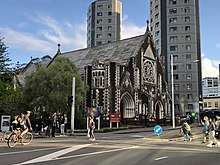 | |
| Location | 28 Symonds Street, Auckland |
| Country | New Zealand |
| Denomination | Anglican |
| Website |
www |
| History | |
| Founded | 1841 |
| Founder(s) | Governor William Hobson |
| Dedicated | 1894 |
| Architecture | |
| Architect(s) | William Henry Skinner |
| Style | Victorian Gothic |
| Years built | 1894-1895 |
| Administration | |
| Parish | St Paul's Symonds Street |
| Diocese | Auckland |
| Clergy | |
| Bishop(s) | Ross Bay |
| Vicar(s) | Jonny Grant |
| Priest(s) | Matthew Bruns |
St Paul's Church is a historic church in the CBD of Auckland, New Zealand, located on Symonds Street near the University of Auckland and Auckland University of Technology. It is the longest established church in the city and has one of the largest Anglican congregations in Australasia.[1][2]
St Paul's is known as the "Mother Church" of Auckland as the original building was the first church to be built in the city, in the same year that the original town was established. The St Paul's foundation stone was laid by Governor William Hobson on 28 July 1841 and the first service was held on 7 May 1843. St Paul's also served as Auckland's Cathedral for over 40 years. The third and current building was formally consecrated by Bishop William Cowie on 1 November 1895, and is now registered as a Category 1 Historic Place.[3][4]
History
Early history
Now occupying its third building, St Paul’s is the oldest church in the city of Auckland. The first St Paul’s was built in Emily Place, just off Princes St, in 1841 where a plaque still marks the site of the beginning of the Christian church in Auckland.
Old St Paul’s was in the centre of the young colonial city, on a prominent ridge-top site on Point Britomart, close to the imperial garrison stationed at Fort Britomart, and near the remnants of the old Rangipuke pā where Ngāti Whātua had defended their rohe during the Musket Wars of the 1820s. St Paul’s was the seat of the Bishop of New Zealand, the Right Reverend George Selwyn, and Auckland's wealthiest settlers worshipped there. The religion of British royalty, the Anglican faith was closely linked to colonial power. Many of St Paul’s artefacts, such as Selwyn’s Throne and a large collection of memorials, are connected to this time.[4][5][6]
Reverend John Churton was the first minister of St Paul's, occupying that role for 12 years. The Churton Memorial was built to his memory, close to the site of the original church building.[4] In 1863 the original building received extensive enlargements which doubled the seating capacity.[7]
During the height of the New Zealand Wars in the 1860s, St Paul's was used as a safe haven for women, children and the elderly; a traditional church role in times of strife.[8] After the war moved south, however, and Auckland expanded geographically, the congregation dwindled as attendees moved to the new suburbs of Epsom and Remuera, and St Matthew’s in the City served the suburbs of Freeman’s Bay and Ponsonby.[9][5]
Changing locations
The original Emily Place church was demolished in 1885, when Point Britomart was quarried away. A temporary wooden church, designed by William Skinner, was built on the corner of Short St and Eden Crescent while a permanent church site was identified.[10][11]
Only the present site, halfway up the Symonds St hill, was considered large and central enough for the planned church. It also placed it near Auckland's oldest street, Karangahape Road, which by the 1880s was a thriving thoroughfare and shopping precinct for both Māori and Pākehā. The road was a traditional walking track along the ridge from Owairaka (Mt Albert) to Orakei for Ngāti Whātua. The official municipal burial ground; the Symonds Street Cemetery was also nearby, on the corner of K’Rd and Symonds St.[5][12]
The new church building was dedicated in 1894, without the corner tower and steeple that were part of Skinner’s design. The Long Depression had inhibited building such a monumental church. The interior was kept plain, apart from the rose window temporarily filled with coloured cathedral glass and the artefacts gifted by Selwyn.[5][11][13]
The appointment of Reverend C.A.B Watson in 1908 led to St Paul's being revitalised as a centre of Anglo-Catholicism in a largely puritanical city. Watson, and his successor Samuel Corbin shaped the church for a half-century, introducing Sung Mass, choral music and the concept of spiritual healing, which received some resistance.[5][10]
20th century renewal
In 1954 Father Kenneth Prebble inherited a building and congregation both in a poor state, and for the next 20 years he reestablished St Paul's as a centre of Anglo-Catholocism. In the mid-1960s Prebble looked beyond the norm in terms of high church Anglican practise and embraced a revival of the Holy Spirit. Polarising the congregation, St Paul’s became Spirit-focused, evangelical and contemporary while maintaining it's Anglo-Catholic theology. Through it's popular music, and a regular coffee-shop outreach to students and young people, Prebble and his successor Father David Balfour, helped create a church with city-wide and international impact through the 50s and 60s.[14][15]
From 1956 to 1973 many repairs and additions were made to the building, including: cleaning, repairing and replacing stonework; replacing the roof; and the addition of the "Endean Memorial", "Christ in Glory" and "Patteson Memorial" stained glass windows.[16][17]
In 1974 the St Paul's Outreach Trust was formed and by the end of 1975 had produced three records sung by the St Paul's Singers entitled Songs for Prayer & Praise, Arise my Love and Harvest of Joy, plus a songbook called New Glory.[15][14] However, in the 1970s, the Anglo-Catholicism that had provided the theological framework for the spiritual and social justice revival of the 50s and 60s at St Paul’s "dissolved into a bundle of conflicting theologies without strong leadership or good biblical teaching".[5]
During the 1980s and 1990s the parish, with the help of its first Māori curate Wally Te Ura, took steps towards a “more significant understanding of bi-culturalism” and a Friday night gospel service was established which became an outreach to immigrant families and students from Asian countries. The parish also continued taking an active role in supporting women clergy. However, many congregants of the previous period moved away, and only a "tiny remnant" of Anglo-Catholics remained loyal to the church.[5][9][18]
21st century renewal
During the late 1990s and early 2000s, many young New Zealanders became Christians or renewed their faith at St Mary’s London. Returning home, they wanted a similar church in Auckland. With the blessing of the Bishop of Auckland, a team from St Mary’s were invited in 2004 to set up new family and young people-focused services at St Paul’s, Symonds St. Mike and Bex Norris and a core congregation of about 80 people whom had previously attended St Mary’s in London, oversaw huge growth, with well over a thousand congregants registered by 2009.[18]
From 2009 to 2013, St Paul's produced the GLOW Carols by Glowstick event at Auckland's Vector Arena, with around 10,000 people attending each year. A key part of the event were Christmas films produced by St Paul's including The Christmas Story which has had 4 million views on YouTube.[19][20][21] The 2012 documentary short film O Little Town of Bethlehem was shot in modern Bethlehem.[22][23][21] In 2012 St Paul's produced its debut live worship album titled GOD w/ US including the voices of around 800 worshippers gathered across three services.[24]
In 2015 St Paul's published a hard cover book of personal testimonies and photos of 128 children, youth and adults from the church called Stories.[25] From 2015 to 2017, St Paul's has produced Alt Carols as an alternative Christmas experience, combining creative elements of music, art and design. Volume One of the remixed carols from the events was released as an album in 2017.[26]
St Paul’s has a staff of about 20 which includes a vicar, a priest assistant, a worship leader, four in pastoral care, five in children and youth, and seven in operations.[27]
Gallery
 The Auckland waterfront with Māori waka and the original St Paul's building above Point Britomart, painted in 1852.
The Auckland waterfront with Māori waka and the original St Paul's building above Point Britomart, painted in 1852.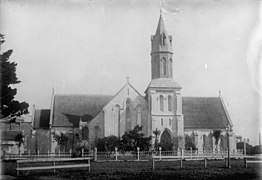 The original St Paul's building, photographed in the 1880s.
The original St Paul's building, photographed in the 1880s.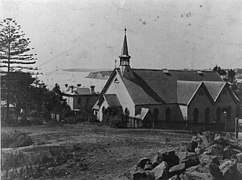 The temporary St Paul's building photographed in the 1880s.
The temporary St Paul's building photographed in the 1880s.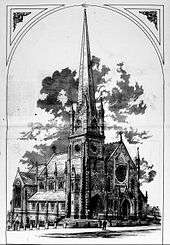 Architect's perspective of the third building published in 1894, showing the unbuilt steeple.
Architect's perspective of the third building published in 1894, showing the unbuilt steeple.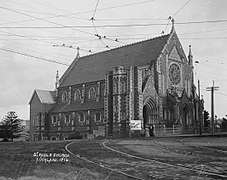 The third and current St Paul's building photographed in 1909.
The third and current St Paul's building photographed in 1909.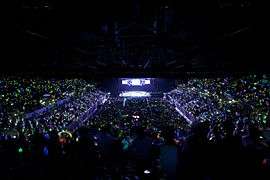 St Paul's GLOW Carols by Glowstick annual event at Vector Arena, 2011.
St Paul's GLOW Carols by Glowstick annual event at Vector Arena, 2011..jpg) St Paul's Evening Service, 2012.
St Paul's Evening Service, 2012.
References
- ↑ "St Paul's Church (Anglican)". New Zealand Historic Places Trust. Retrieved 19 November 2016.
- ↑ "Jonathan Grant". Baker Publishing Group. Retrieved 31 October 2015.
- ↑ "History of the Diocese of Auckland". Anglican Diocese of Auckland. Retrieved 19 November 2016.
- 1 2 3 "Churton Memorial". New Zealand Historic Places Trust. Retrieved 16 October 2013.
- 1 2 3 4 5 6 7 "Where we've come from". Kate Hannah (Research Development Manager, The University of Auckland) St Paul's Church, Auckland. Retrieved 16 October 2013.
- ↑ "St Paul's Church memorials, Auckland". New Zealand History. Retrieved 6 October 2018.
- ↑ "New Zealander". 7 September 1863. Retrieved 6 October 2018.
- ↑ "Auckland Star". 24 July 1926. Retrieved 30 September 2018.
- 1 2 Eaglen, Jackie (1991). A Brief History of St. Paul's Symonds Street. St Paul's Outreach Trust.
- 1 2 Historic Buildings of NZ, North Island. Methven Publications (NZ) Ltd. 1983. p. 112-113.
- 1 2 "New Zealand Herald". 28 July 1916. Retrieved 6 October 2018.
- ↑ "Auckland's 175th anniversary: No easy road to street names". NZ Herald. Retrieved 6 October 2018.
- ↑ "STAINED Talk 2". St Paul's. Retrieved 19 August 2018.
- 1 2 Merritt, N.F.H. (1981). To God be the Glory. St Paul's Outreach Trust.
- 1 2 "Kenneth Ralph Prebble". Stuff. Retrieved 30 September 2018.
- ↑ A Plan for the Preservation of St Paul's Church Auckland. Salmond Architects. 1998.
- ↑ "STAINED Talk 3". St Paul's. Retrieved 7 October 2018.
- 1 2 "Unplugging the wells of blessing". Anglican Taonga. 2009. Retrieved 19 August 2018.
- ↑ "Carols by glow-stick at Vector Arena". NZ Herald. Retrieved 21 January 2018.
- ↑ "The story of Christmas - A Kiwi version". NZ Herald. Retrieved 21 January 2018.
- 1 2 "St Paul's Arts & Media". YouTube. Retrieved 21 January 2018.
- ↑ "Christmas in modern-day Bethlehem". News Hub. Retrieved 6 October 2018.
- ↑ "Roundup: Animated Nativity short; Bethlehem speaks; "Glory in the Darkest Place"; Norwegian jazz; gilding goldfinch". Art & Theology. Retrieved 6 October 2018.
- ↑ "GOD w/ US CD". St Paul's. Retrieved 21 January 2018.
- ↑ "St Paul's Stories". St Paul's. Retrieved 19 August 2018.
- ↑ "Alt Carols". St Paul's. Retrieved 21 January 2018.
- ↑ "The Team". St Paul's Church, Auckland. Retrieved 26 August 2017.
External links
| Wikimedia Commons has media related to St Paul's Church, Auckland. |